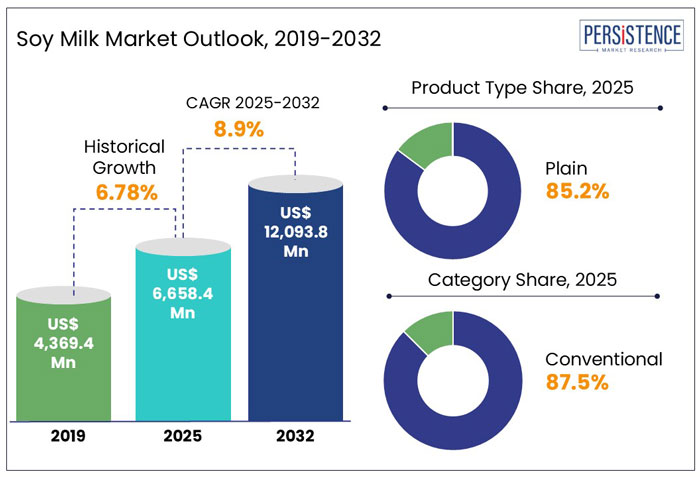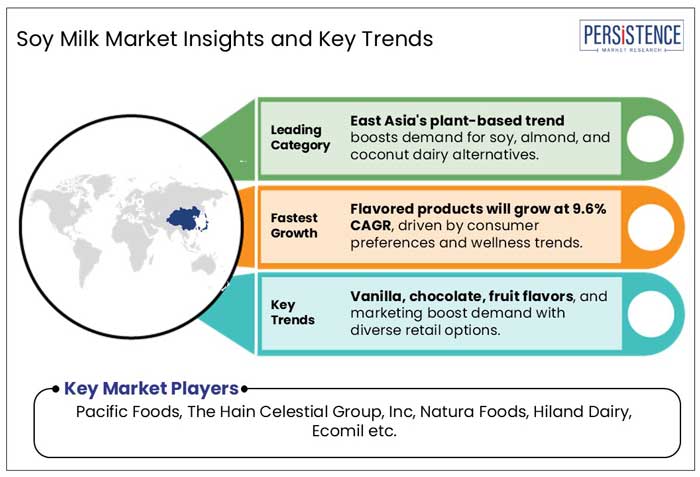Industry: Food and Beverages
Published Date: March-2025
Format: PPT*, PDF, EXCEL
Delivery Timelines: Contact Sales
Number of Pages: 300
Report ID: PMRREP32165
According to Persistence Market Research, the Global Soy Milk Market is estimated to increase from US$ 6,658.4 Mn in 2025 to US$ 12,093.8 Mn by 2032. The market is projected to record a CAGR of 8.9% during the forecast period from 2025 to 2032.

Key Highlights of the Market
|
Market Attributes |
Key Insights |
|
Global Soy Milk Market Size (2025E) |
US$ 6,658.4 Mn |
|
Projected Market Value (2032F) |
US$ 12,093.8 Mn |
|
North America Market Growth Rate (CAGR 2025 to 2032) |
8.9% |
|
Historical Market Growth Rate (CAGR 2019 to 2023) |
6.8% |
Soy milk evolved as a primary substitute for dairy milk, which is obtained from soybean. It is considered as a traditional vegetable protein beverage, which has created a significant demand across the globe due to multiple factors like ethics, environmental concerns and health consciousness. Furthermore, with government support and growing promotions for inclination of plant-based diet in various countries such as the United Kingdom, France, and Sweden, is estimated to have a positive influence on the market.
“Potential Health Benefits Offered by Soy Milk to Support the Growth of the Market”
In recent years, it has become evident that the non-dairy milk sector is getting overcrowded owing to a lot of reasons. One of the core reasons for this is the potential health benefits of soy milk over other non-dairy alternatives. Consumers are shifting towards soy milk to avoid dairy for various reasons, such as health or weight loss.
Soy milk is known for its ability to aid various health problems, such as decreasing cholesterol levels which reduces the risk of coronary heart disease. The presence of isoflavones is considered to one of the most important and unique benefits offered by soy milk. It is known to have benefits such as reducing the risk of certain cancers, prevention of osteoporosis and easing of menopause symptoms. Its antioxidant and anti-inflammatory properties are known to promote gut health and good heart health. Soy milk is also considered to have a good impact on hair growth when combined with a protein-rich diet. These proven health benefits offered by the consumption of soy milk are expected to boost the global market for soy milk.

The global soy milk market presented strong growth in the historical period assessment and registered a value CAGR of 6.8% to reach market valuation of around US$ 4,369.4 Mn in 2019.
The market in historical period observed high consumption in retail/household, due to buoyant demand for tetra pack plant-based beverages in hypermarket/supermarket, convenience stores, specialty stores and online retail.
Manufacturers of soy milk aim to set up a robust supply chain to ensure the availability of high-quality ingredients for production soy milk, which will also provide extended shelf life to products. The players harness the state-of-art- equipment for manufacturing soy milk and aim to strengthen the production capabilities to meet the demand emerging from the foodservice industry. Global value of the spices industry is anticipated to increase at a CAGR of 8.9% through 2032 and reach a market size of US$ 12,093.8 Mn by 2032.
“Growing Consumption of Lactose-free Milk”
Growing incidence of lactose intolerance due to inability of human body to absorb lactose present in the milk and suffer from diarrhea, bloating, or flatulence, which led the consumers seek alternatives for dairy milk. Moreover, the rising cases of digestive disorders from milk among the global population is paving the way for several milk substitutes. Almond milk, soy milk, and soy milk are ideal alternatives to animal milk, as these varieties also contain protein, vitamins, and other nutrients.
Manufacturers are offering a wide range of plant-based milk varieties, and the increasing demand for lactose-free beverages is expected to drive the sales of plant-based milk products.
This growing consumer shift toward dairy alternatives is expected to further boost innovation and expansion in the plant-based milk market.
Competition for Other Non-Dairy Alternatives
One of the major restraints for the market is the intense competition from other plant-based milk alternatives such as almond, oat, and coconut milk. These options are gaining popularity due to their perceived benefits, including better taste, lower calorie content, and affordability. Many consumers prefer almond or oat milk for their mild flavor and nutritional profile, making it challenging for soy milk to maintain its market share.
Additionally, some plant-based milk brands focus on sustainability and allergen-free claims, which further attract health-conscious buyers. This growing preference for alternative dairy-free options poses a significant challenge to soy milk sales.
Plain Soy Milk is the Largest Contributor in 2024
Plain soy milk holds the largest market share among product types, accounting for 85.2% of the market. Its growing preference is driven by its perception as a healthier choice compared to flavored variants, which often contain additives, preservatives, and added sugars. Health-conscious consumers favor plain soy milk for its natural composition, while its lower cost compared to flavored options also appeals to budget-conscious buyers. Despite initial challenges due to its bitter taste, manufacturers have improved the quality, and demand for plain soy milk continues to rise, solidifying its dominance in the plant-based milk market.
The retail sales of soy milk products are expected to show higher growth at a CAGR of 9.5% in the global market during the forecast period (2025-2032). The rising health-consciousness and growing consumer shift towards plant-based diets are some of the key factors that are positively affecting the growth.
The growing adoption of plant-based diets in East Asia is significantly driving demand for soy milk. As more consumers shift towards vegetarian and vegan lifestyles, soy milk is becoming a popular alternative to dairy. Countries like China, Japan, and South Korea are witnessing an increasing preference for plant-based beverages due to health benefits, lactose intolerance, and sustainability concerns. Many consumers in the region are turning to soy milk as a source of protein, vitamins, and minerals, making it a staple in daily diets.
In China, the demand for soy milk is rising due to traditional consumption habits and modern health trends. Additionally, Japan’s aging population is driving interest in plant-based diets to manage health conditions like high cholesterol and diabetes. In South Korea, the popularity of plant-based diets among younger generations and fitness enthusiasts is further boosting soy milk sales.
The market is also benefiting from innovation in soy milk Flavors, packaging, and fortified options. Companies are introducing organic and sugar-free variants to attract health-conscious consumers. With strong cultural acceptance of soy-based foods and increasing awareness about sustainable diets, the adoption of plant-based diets in East Asia is expected to keep driving the soy milk market’s growth in the coming years.
The U.S. is leading the North America soy milk market due to growing demand for plant-based alternatives. According to USDA statistics, U.S. dairy producers increased milk sales by approximately 0.8% compared to 2023, but rising lactose intolerance and vegan lifestyles are boosting soy milk consumption.
Supermarkets and online stores are expanding their plant-based dairy sections, further driving growth. Additionally, advancements in soy milk production, including better taste and nutrition, are attracting more consumers. With strong marketing efforts and increasing consumer awareness, the U.S. remains the top player in North America's soy milk industry, outpacing other regional markets.
Multinational and international players majorly dominate the global soy milk market. An approximate share of 35-40% is held by the producers having a wide presence in the country. Players in the global market are targeting their product offerings specially toward retail/household and foodservice providers. The foodservice industry is also projected to capitalize on the veganism trend and the utilization of soy milk products is anticipated to increase in the HoReCa sector and other foodservice institutions.
Manufacturers strategize to offer products that are in line with the market trends and consumer requirements to attract consumers. Producers are focusing on incorporating advanced technology to ramp-up production of soy milk to meet emerging demand for plant-based products.
Recent Developments in the Global Soy Milk Market
|
Attributes |
Details |
|
Current and Forecast Period |
2024 to 2032 |
|
Historical Data Available for |
2019 to 2023 |
|
Market Analysis |
US$ Million for Value |
|
Key Country Covered |
|
|
Key Market Segments Covered |
|
|
Key Companies Profiled |
|
|
Report Coverage |
|
|
Customization & Pricing |
Available upon request |
By Product Type
By Category
By End Use
By Distribution Channel
By Region
To know more about delivery timeline for this report Contact Sales

Soy milk is estimated to increase from US$ 6,658.4 Mn in 2025 to US$ 12,093.8 Mn by 2032.
Rising lactose intolerance, increasing vegan population, health benefits, sustainability concerns, and expanding dairy alternatives drive the global soy milk industry, with innovations in flavors and fortification further boosting market demand.
Pacific Foods, The Hain Celestial Group, Inc, Natura Foods, Hiland Dairy, Ecomil are some of the leading industry players.
The market is projected to record a CAGR of 8.9% during the forecast period from 2025 to 2032.
Rising demand for fortified, organic, and flavored soy milk presents significant growth opportunities globally.